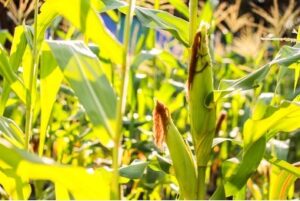HYBRID- AN OVERVIEW
- A hybrid is the offspring resulting from cross-breeding of two organisms of different breeds, varieties, species or genera through sexual reproduction.
- Hybrids are not always intermediates between their parents, but can show Heterosis/hybrid vigor.
- Many commercially useful fruits, flowers, garden herbs, and trees have been produced by hybridisation. The crossing of wild and domesticated species is common in modern agriculture including horticulture.
- Human impact on the environment has resulted in an increase in the interbreeding between regional species, and the proliferation of introduced species worldwide has also resulted in an increase in hybridisation. However, this genetic mixing may threaten many species with extinction, while genetic erosion from monoculture in crop plants may be damaging the gene pools of many species for future breeding.
- Human selective breeding of domesticated animals and plants has resulted in the development of distinct breeds (called cultivars with respect to plants); crossbreeds between them.
Reproductive isolation
- Interspecific hybrids are produced by mating individuals from two species, normally within the same genus. The offspring shows traits and characteristics of both parents, but are often sterile, preventing gene flow between the species.
- Sterility is often being result of the different number of chromosomes between the two species. For example, donkeyshave 62 chromosomes, horses have 64 and mules or hinnies have 63 chromosomes. Mules and hinnies are sterile interspecific hybrids and cannot produce viable gametes, due to differences in chromosome structure. This difference prevents pairing and segregation during meiosis. Thus, meiosis is disrupted and viable sperm and eggs are not formed.
- In plants, blooming period differences, different pollinator vectors, inhibition of pollen tube growth, cytoplasmic-genic male sterility and structural differences of the chromosomes are some barriers to hybridization.
Animal and plant breeding
- Single cross hybrids result from the cross between two true-breeding organisms which produces an F1 hybrid (first filial generation). The cross between two different homozygous lines produces an F1 hybrid that is heterozygous. It has two alleles, one contributed by each parent and typically one is dominant and the other is recessive.
- Double cross hybrids result from the cross between two different F1 hybrids (i.e., there are four unrelated grandparents). Three-way cross hybrids result from the cross between an F1 hybrid and an inbred line.
- Triple cross hybrids result from the crossing of two different three-way cross hybrids. Top cross hybrids result from the crossing of a top quality or pure-bred male and a lower quality female, intended to improve the quality of the offspring.
Hybrid and Genetics
- A genetic hybrid carries two different alleles of the same gene, where for instance one allele may code for taller length than the other.
- A structural hybrid results from the fusion of gametes that have differing structure in at least one chromosome, due to structural aberration.
- A numerical hybrid results from the fusion of gametes having different haploid numbers of chromosomes.
- A permanent hybrid results when only the heterozygous genotype occurs, as in Oenothera lamarckiana, because all homozygous combinations are lethal.
Hybrid vigour
- Heterosis or hybrid vigor is the increased function (productivity or superiority) such as size, growth rate, fertility, and yield in a hybrid offspring.
- Heterosis can be the result of the masking of deleterious recessives by dominant or partially dominant alleles, result in a hybrid with different collection of favorable dominants.
- This is most common with plant hybrids.
- Positive heterosis produces more robust hybrids; they might be stronger or bigger. Negative heterosis refers to weaker or smaller hybrids.
Impacts by Human
There are many species hybrids in nature (in ducks, blackberries, etc.), although naturally occurring hybrids between two genera have been noted, most of these latter result from human intervention.
Hybridization is greatly influenced by human impact on the environment, through habitat fragmentation and species introductions. Such impacts make it difficult to conserve the genetics of populations undergoing introgressive hybridization. Introductions can drastically affect populations, including through hybridization.
Effect on biodiversity and food security
The modern era relied on hybridization to create high-yielding varieties. The replacement of locally indigenous breeds, compounded with unintentional cross-pollination and crossbreeding, has reduced the gene pools of various wild and indigenous breeds resulting in the loss of genetic diversity.
Usually, the indigenous breeds are well-adapted to locality in climate and have immunity to local pathogens; this can be a significant genetic erosion of the gene pool for future breeding.
That’s why commercial plant geneticists strive to breed “widely adapted” cultivars to counteract this tendency.

In Plants
- Plant species hybridize more readily than animal species, and the resulting hybrids are often more fertile.
- Many plant species are the result of hybridization, combined with polyploidy, which duplicates the chromosomes. Chromosome duplication allows orderly meiosis and so viable seed can be produced.
- Crops and their wild relatives are hybridizing to improve disease-resistance or climate resilience for both agricultural and horticultural crops.
- Some crop plants are hybrids from different genera, called as intergeneric hybrids. Example is Triticale, a wheat–rye hybrid. Bread wheat, Triticum aestivum, is a hexaploid hybrid of three wild grasses. Triploid bananas and watermelons are intentionally bred because they produce no seeds and are also parthenocarpic.
Read also…
HETEROSIS AND INBREEDING DEPRESSION
WHAT IS HYBRIDIZATION- AIM & TYPES
REPRODUCTION IN PLANTS-TYPES & USE